SeaSpray™ DC Nebulizer
The high dissolved solids nebulizer
The SeaSpray™ concentric DC nebulizer offers outstanding nebulization efficiency for trace level analyses. It offers freedom from clogging while nebulizing solutions to the limit of solubility of most mineral salts, and conferring significant sensitivity gains. The SeaSpray™ concentric DC nebulizer has the the highest sensitivity for any concentric nebulizer on the market.
- Material: Borosilicate glass
- High physical reproducibility ~ 1%
- TDS tolerance, typically up to 20%
- High tolerance to particulates, typically up to 75µm
- Low RSD's due to highly accurate construction
- Standard available uptake: 0.4mL/min and 2mL/min
For low-level boron analysis we recommend a Quartz SeaSpray.
Order SeaSpray for your ICP

Product Features
Simply the Best!
The SeaSpray™ DC nebulizer has rewritten the rules for analysis with ICP-OES and ICP-MS, providing improved precision and sensitivity as well as freedom from clogging.
The SeaSpray combines a unique self-washing tip with the revolutionary Glass Expansion VitriCone construction. The SeaSpray nebulizer tip has been carefully designed with smooth surfaces to minimize the adhesion of salt crystals. The design also uses the washing action of the dispersing droplets to further prevent crystal growth, allowing the SeaSpray to handle up to 20% salt solutions.
With some concentric glass nebulizer brands, the sample channel is constructed from fine drawn out capillary tubing. Glass Expansion nebulizers on the other hand, use the unique VitriCone construction. With the VitriCone design the sample channel is constructed from heavy glass capillary which is machined to very tight tolerances.
- The sample channel is uniform, so salt deposition is inhibited.
- The industry’s tightest tolerances ensure that each nebulizer will perform to the same high standards as the previous one.

With the SeaSpray U-Series and DC nebulizer, our proprietary UniFit connector slides easily over the sample arm and creates an excellent seal. As with all U-Series and DC nebulizers, the sample channel is uniform from the entry point to the tip so there is nowhere for particulates to be trapped. Since there is nowhere for the sample to be trapped, you get the fastest possible washout and highest sample throughput. We supply SeaSpray U-Series and DC nebulizers for all ICP-OES and ICP-MS spectrometers.
Direct Connection (DC) Nebulizer
The DC nebulizer has a UniFit sample connector that slides easily over the sample arm and an argon gas connector configured to connect directly to your ICP. The benefits of the DC nebulizer are:
- Inert metal-free argon gas connector.
- Instrument-specific Direct Connect flexible argon gas line.
- Reliable ratchet fitting ensures a leak-free argon gas connection.
DC versions of the SeaSpray, MicroMist, Conikal, Slurry, DuraMist, OpalMist, and VeeSpray nebulizers are available to suit the most common models of ICP-OES and ICP-MS.
The DC nebulizer part number has a prefix specific to each type of gas connector. For example, the prefix "A13-" denotes a connector for the Agilent® 5100/5110/5800/5900 ICP-OES, so part number A13-07-USS2 is a SeaSpray nebulizer configured for direct connection to the Agilent® 5100/5110/5800/5900. See Understanding Glass Expansion nebulizer part numbers for a full list of available DC nebulizers, or Choose a Nebulizer to suit your ICP to see the DC nebulizers for your particular ICP model.
Find a SeaSpray nebulizer to suit your instrument:
| Manufacturer | Model |
| Agilent® | 5100, 5110, 5800, 5900 |
| Agilent® | 8900 |
| Agilent® | 7900 |
| Agilent® | 7800, 7850 |
| Perkin Elmer® | NexION 5000 |
| Perkin Elmer® | NexION 1000, 1100, 2000 |
| Perkin Elmer® | NexION 300, 350 |
| Shimadzu® | ICPM-8500, ICPMS-2030 |
| Thermo Scientific™ | PRO Duo |
| Thermo Scientific™ | PRO Radial |
| Thermo Scientific™ | MX Series |
| Thermo Scientific™ | Q, RQ, TQ |
| Thermo Scientific™ | Neoma MC-ICP-MS |
For more instrument models click HERE
MicroMist™ DC Nebulizer
Designed for Excellent Transport Efficiency and Precision
Glass Expansion's MicroMist™ Direct Connect (DC) nebulizer is ideal for low-flow applications due to its excellent transport efficiency and precision. Backed by industry's tightest tolerances, precision manufacturing, and the proprietary VitriCone™ capillary have driven the MicroMist DC nebulizer to be the worldwide standard nebulizer for low-flow ICP-OES and ICP-MS applications.
- Material: Borosilicate glass
- High physical reproducibility ~ 1%
- TDS tolerance, typically up to 15%
- Highest transport efficiency
- Low RSD's due to highly accurate construction
- Standard available uptake: 0.05, 0.1, 0.2, 0.4, 0.5 & 0.6mL/min
Order MicroMist Nebulizer

Product Features
- Proprietary sample channel is guaranteed uniform from entry point to nebulizer tip and thus resistant to clogging.
- Rugged precision-machined borosilicate glass capillary resists vibration and delivers the best possible precision.
- Industry's tightest tolerances ensure that each nebulizer will perform to the same high standards as the previous one, physical reproducibility within 1%.
- Slides easily over the sample arm, creating an excellent insert seal and provides a zero-dead volume sample connection.
- A zero-dead volume connection ensures the fastest washout and highest sample throughput, since there is nowhere for sample to be trapped.
- Inert metal-free argon gas connector.
- Reliable ratchet fitting ensures leak-free nebulizer gas connection.
- Instrument-specific Direct Connect flexible argon gas line (click here for the DC video installation guide).

The DC nebulizer part number has a prefix specific to each type of gas connector. For example, the prefix "A13-" denotes a connector for the Agilent® 7700/7800/7850/7900/8800/8900, so part number A13-1-UM04 is a MicroMist DC nebulizer configured for direct connection to the Agilent® ICP-MS 7700/7800/7850/7900/8800/8900. (Click here for a full list of available DC gas connectors).
Performance
Although the MicroMist nebulizer operates at a lower sample flow rate, the transport efficiency is significantly higher compared to a standard concentric nebulizer. The graph illustrates the relationship between uptake rate and nebulizer efficiency (the percentage of the sample that reaches the plasma as opposed to going down the drain).

At 50 µL/min the MicroMist has a 50% efficiency and therefore injects 25 µL/min into the plasma. On the other hand, a standard 2 mL/min concentric nebulizer has a 2% efficiency, resulting in 40 µL/min of sample injected into the plasma. This means that the MicroMist nebulizer can reduce sample consumption by a factor of 40, and yet the sensitivity is reduced by less than a factor of two. For this reason, the MicroMist is the first choice for applications with limited sample volumes.
With a strong and consistent self-aspiration, the MicroMist nebulizers can be used with or without a peristaltic pump. The MicroMist product line includes models with natural sample uptake rates of 50, 100, 200, 400 and 600 µL/min. When choosing a MicroMist nebulizer, select the model that most closely matches your desired sample flow rate. It is always OK to starve a nebulizer, but you should not exceed the natural sample uptake rate.
The smaller droplet size of the MicroMist nebulizer has additional analytical advantages, including reduced matrix interferences and a more robust plasma.
Although the MicroMist nebulizer is a low-flow nebulizer, it still provides a relatively high tolerance to total dissolved solids (TDS) at 15%. Providing the ability to handle a wide range of sample types, including challenging samples such as wastewater, soil, blood, serum, and urine. For the enhanced tolerance to TDS, consider adding an argon humidifier, such as our Elegra.
- Any ICP-OES and ICP-MS application demanding the highest transport efficiency and precision.
- Samples with limited volume, such as biological samples.
- Samples of high value, such as precious metals and fine chemicals.
- Hazardous or radioactive that are difficult to dispose of.
- Any organics and highly volatile organics that are challenging due to plasma instability.
- Isotope ratio and single-event ICP-MS (single-cell, single particle, and nanoparticle) analysis, where precision and efficiency are critical. Applications requiring the highest sensitivity and precision, such as toxic metals in cannabis.
Find a MicroMist™ nebulizer to suit your ICP-MS or ICP-OES:
| Manufacturer | Model |
| Agilent® | 5100, 5110, 5800, 5900 |
| Agilent® | 8900 |
| Agilent® | 7900 |
| Agilent® | 7800, 7850 |
| Agilent® | 7700, 8800 |
| Analytik Jena | PlasmaQuant MS Series |
| Perkin Elmer® | Avio 200, 500 Series |
| Perkin Elmer® | NexION 2200, 5000 |
| Perkin Elmer® | NexION 1000, 1100, 2000 |
| Perkin Elmer® | NexION 300, 350 |
| Shimadzu® | ICPM-8500, ICPMS-2030 |
| Thermo Scientific™ | PRO DUO |
| Thermo Scientific™ | PRO Radial |
| Thermo Scientific™ | MX Series |
| Thermo Scientific™ | Q, RQ, TQ |
| Thermo Scientific™ | Neoma MC-ICP-MS |
For more instrument models click HERE
Conikal™ Nebulizer
An Industry Standard
The Conikal concentric nebulizer gives the most reproducible results for standard ICP analyses. It represents the choice of nebulizer for high precision, routine aqueous, and organic applications.
- Material: Borosilicate glass
- High physical reproducibility ~ 1%
- TDS tolerance, typically up to 5%
- High tolerance to particulates, typically up to 75μm
- Low RSD’s due to highly accurate construction
- Standard available uptake: 1 & 2 mL/min
Order Conikal Nebulizer

Common Conikal Sample Uptake and Connection Options
Depending on your sample uptake, Conikal nebulizers are supplied with the below sample connectors:
| Product | Sample Uptake | Sample Connector | Sample Tube ID | Sample Tube OD | Sample Tube Length |
| Conikal U-Series nebulizers | 2mL/min | UniFit connector P/N: NFT-16-75
|
0.75mm | 1.6mm | 700mm |
|
Conikal U-Series nebulizers
|
1mL/min | UniFit connector P/N: NFT-16-50 | 0.50mm | 1.6mm | 700mm |
|
Conikal EzyFit nebulizers
|
2mL/min | UniFit connector P/N: EZT-16-75 | 0.75mm | 1.6mm | 700mm |
| Conikal EzyFit nebulizers | 1mL/min | UniFit connector P/N: EZT-16-50 | 0.50mm | 1.6mm | 700mm |
*All Conikal U-Series nebulizers are supplied with the EzyLok argon connector. Conikal EzyFit nebulizers with an 'E' at the end of the part number are supplied with the EzyLok argon connector.
Slurry™ Nebulizer
For slurries or suspensions
The Slurry glass concentric nebulizer is ideal for specialized applications requiring the aspiration of slurries or suspensions. Its capillary bore is 50% larger than standard concentric, which reduces the possibility of particle blockage while giving excellent signal stability.
- Material: Borosilicate glass
- High physical reproducibility ~ 1%
- TDS tolerance, typically ~ 1%
- High tolerance to particulates, typically up to 150µm
- Low RSD's due to highly accurate construction
- Slurry nebulizers have a natural liquid uptake of 4mL/min but operate best between 1.5 - 2.5mL/min
Order Slurry Nebulizer

Common Slurry Sample Uptake and Connection Options
Depending on your product, Slurry nebulizers are supplied with the below sample connectors:
| Product | Sample Connector | Sample Tube ID | Sample Tube OD | Sample Tube Length |
|
Slurry U-Series nebulizers
|
UniFit connector P/N: NFT-16-75 | 0.75mm | 1.6mm | 700mm |
| Slurry EzyFit nebulizers | UniFit connector P/N: EZT-16-75 | 0.75mm | 1.6mm | 700mm |
All Slurry U-Series nebulizers are supplied with the EzyLok argon connector. Slurry EzyFit nebulizers with an 'E' at the end of the part number are supplied with the EzyLok argon connector.
Ceramic VeeSpray™ Nebulizer
Handles High Particle and TDS Loads Best
The Ceramic VeeSpray nebulizer is made from alumina ceramic, making it ideal for HF analyses. It provides reproducible performance when working with samples containing large particulates. It has the same 6mm diameter as the standard concentric, and the Alumina material makes it the most robust and abrasion-resistant ICP nebulizer.
- Material: 99.8% Alumina Ceramic
- High physical reproducibility ~ 1%
- TDS tolerance, typically up to 30%
- High tolerance to particulates, typically up to 300µm
- Must be pumped - does not self-aspirate
- Design uptake range: 0.6 - 3mL/min. Operates best between 1.5 - 2.5mL/min
Order VeeSpray Nebulizer

VeeSpray Nebulizer Tubing and Connection Options
| Product | Description |
|
STT-16-75 |
Standard Sample Tubing 1/16 OD x 0.75mm ID x 10m long |
|
70-803-1350 |
Ratchet connectors |
| 70-803-0780 | Ferrule 1/16 for VeeSpray nebulizer (PKT 10) |
All Ceramic VeeSpray nebulizers listed in this website are supplied with 750mm length of STT-16-75 sample tubing (sample tube 0.75mm ID x 1.6mm OD), Two ratchet connectors P/N 70-803-1350 and ferrules 70-803-0780.
DuraMist™ DC Nebulizer
For routine high precision HF analyses
Glass Expansion's DuraMist™ DC Nebulizer is one of our most versatile and durable concentric nebulizer designs. Manufactured with a PEEK body and PTFE capillary insert, the DuraMist can handle the toughest acid matrices, including up to 5% Hydrofluoric Acid (HF). A uniquely designed smooth tip provides an outstanding tolerance to total dissolved solids (TDS), up to 30%. Manufactured under the most critical specifications, the DuraMist DC delivers superior sensitivity and precision at a cost-effective price.
Available in a 2.0, 1.0 and 0.4 mL/min model, providing a stable self-aspirating sample uptake or can be used in conjunction with your instrument's peristaltic pump or syringe pump for sample delivery. The direct connect installation seamlessly integrates the DuraMist DC nebulizer as a universal nebulizer for all ICP-OES and ICP-MS models.

Product Features
Exceptional tolerance to total dissolved solids (TDS):
A smooth nebulizer tip prevents salt accumulation, which allows for enhanced signal stability and the highest TDS tolerance (up to 30%) of all our concentric nebulizer designs.
High chemical resistivity:
Manufactured with a PEEK body and PTFE capillary insert, provides excellent compatibility with solvents and acids, including up to 5% HF.
High sensitivity and precision:
The rigidity of the PEEK body allows for manufacturing with high physical reproducibility, resulting in an inert concentric nebulizer design that does not compromise sensitivity and precision for demanding ICP-OES and ICP-MS applications. A comparison of the DuraMist DC with the SeaSpray DC, our worldwide market-leading high-performance glass nebulizer, showed that the DuraMist DC gave similar performance.
The following table compares the average intensity and RSD, over a range of elements, for the SeaSpray and DuraMist.
| Nebulizer | Intensity % | RSD % |
| SeaSpray | 100 | 0.23 |
| DuraMist | 87 | 0.28 |
Durability:
In addition to being inert, the rigid PEEK body provides a more durable option compared to PFA nebulizers that are prone to deform over time.
Compatibility:
Available in a 2.0, 1.0 and 0.4 mL/min model, and a direct connection installation, the DuraMist DC nebulizer seamlessly integrates with all ICP-OES and ICP-MS models.
Direct Connection (DC) Nebulizer
The DC nebulizer has a UniFit sample connector that slides easily over the sample arm and an argon gas connector configured to connect directly to your ICP. The benefits of the DC nebulizer are:
- Inert metal-free argon gas connector.
- Instrument-specific Direct Connect flexible argon gas line.
- Reliable ratchet fitting ensures a leak-free argon gas connection.
DC versions of the SeaSpray, MicroMist, Conikal, Slurry, DuraMist, OpalMist, and VeeSpray nebulizers are available to suit the most common models of ICP-OES and ICP-MS.
The DC nebulizer part number has a prefix specific to each type of gas connector. For example, the prefix "A13-" denotes a connector for the Agilent® 5100/5110/5800/5900 ICP-OES, so part number A13-07-USS2 is a SeaSpray nebulizer configured for direct connection to the Agilent® 5100/5110/5800/5900. See Understanding Glass Expansion nebulizer part numbers for a full list of available DC nebulizers, or Choose a Nebulizer to suit your ICP to see the DC nebulizers for your particular ICP model.
Find a DuraMist nebulizer to suit your instrument:
Depending on your sample uptake, DuraMist nebulizers are supplied with the below sample connectors:
| Manufacturer | Model |
| Agilent® | 5100, 5110, 5800, 5900 |
| Agilent® | 8900 |
| Agilent® | 7900 |
| Agilent® | 7800, 7850 |
| Analytik Jena® | PQ9X00 Series |
| Perkin Elmer® | NexION 1000, 1100, 2000 |
| Perkin Elmer® | NexION 300, 350 |
| Shimadzu® | 7000, 8000, 9000, 9800 Series |
| Shimadzu® | ICPM-8500, ICPMS-2030 |
| Spectro® | ARCOSII SOP |
| Spectro® | ARCOSII EOP |
| Spectro® | Spectro Blue SOP & Green SOP/DSOI |
| Spectro® | Spectro Blue EOP/ TI & Green TI |
| Thermo Scientific™ | PRO Duo |
| Thermo Scientific™ | PRO Radial |
| Thermo Scientific™ | Q, RQ, TQ |
For more instrument models click HERE
OpalMist™ PFA DC Concentric Nebulizer
High purity PFA for high precision analysis
The OpalMist™ PFA DC concentric nebulizer is the nebulizer of choice for high precision analyses requiring the highest chemical resistancy to HF, alkalis and organics. The high purity PFA construction makes it ideal for ultra-trace ICP-MS work. The self-aspiration properties of the nebulizer eliminate the need for peristaltic pump tubing which can be source of contamination.
- Material: PFA
- High physical reproducibility ~ 3%
- Strong and consistent self-aspiration
- High tolerance to particulates, up to 75µm, depending on uptake
- TDS tolerance, typically up to 15%
- Low RSD's due to concentric geometry
- Uses only standard ICP argon supply pressures
- Standard 6mm size fits standard cyclonic spray chambers. Adaptors are available for Scott type spray chambers
- Standard available uptakes: 0.05, 0.1, 0.2, 0.4, 0.6, 1 & 2mL/min
Order OpalMist Nebulizer

Product Features
When carrying out ultra-trace analysis, especially by ICP-MS, the risk of contamination must be minimized. The high purity of the PFA material used to make the OpalMist nebulizer provides the exceptionally low background necessary for ultra-trace determinations.
The inert construction of the OpalMist PFA nebulizer enables it to easily handle even the most corrosive samples, such as those containing high levels of hydrofluoric acid (HF) or reactive organic solvents. The OpalMist is also capable of aspirating high concentrations of dissolved solids (typically up to 15%) without clogging. This makes the OpalMist the ideal nebulizer to handle geochemical samples which are typically dissolved in HF and are high in dissolved solids.
The small mean droplet size of the OpalMist™ enhances transport efficiency without increasing noise.
Available with natural uptake rates of 0.01, 0.05, 0.1,0.2, 0.4, 0.6, 1 and 2mL/min. Self-aspiration eliminates the need for peristaltic pump tubing, a potential source of contamination.
Approximately 1%. Meets stringent Quality and Reproducibility Standards expected from Glass Expansion.
For ICP-OES, it is the nebulizer of choice when samples contain both high dissolved solids and HF, but do not contain large particulates (75µm). For ICP-MS, the high purity of PFA makes it the preferred nebulizer for ultra-trace analyses.
Benefits of PFA Nebulizers
PFA nebulizers exhibit superior resistance to a wide range of corrosive chemicals, including strong acids (such as hydrofluoric acid), alkalis, and organic solvents.
PFA's inert nature results in minimal contamination or leaching of elements into samples, ensuring high purity and accuracy in trace element analysis.
PFA nebulizers are widely used in ultra-trace analysis applications due to their low elemental background levels and high purity construction, making them particularly suitable for demanding analytical techniques like ICP-MS.
Ideal for handling geochemical samples dissolved in HF and high in dissolved solids.
Direct Connection (DC) Nebulizer
The DC nebulizer has a UniFit sample connector that slides easily over the sample arm and an argon gas connector configured to connect directly to your ICP. The benefits of the DC nebulizer are:
- Inert metal-free argon gas connector.
- Instrument-specific Direct Connect flexible argon gas line.
- Reliable ratchet fitting ensures a leak-free argon gas connection.
DC versions of the SeaSpray, MicroMist, Conikal, Slurry, DuraMist, OpalMist, and VeeSpray nebulizers are available to suit the most common models of ICP-OES and ICP-MS.
The DC nebulizer part number has a prefix specific to each type of gas connector. For example, the prefix "A13-" denotes a connector for the Agilent® 5100/5110/5800/5900 ICP-OES, so part number A13-07-USS2 is a SeaSpray nebulizer configured for direct connection to the Agilent® 5100/5110/5800/5900. See Understanding Glass Expansion nebulizer part numbers for a full list of available DC nebulizers, or Choose a Nebulizer to suit your ICP to see the DC nebulizers for your particular ICP model.
Find a OpalMist nebulizer to suit your instrument:
| Manufacturer | Model |
| Agilent® | 5100, 5110, 5800, 5900 |
| Agilent® | 8900 |
| Agilent® | 7900 |
| Agilent® | 7800, 7850 |
| Agilent® | 7700, 8800 |
| Analytik Jena® | PlasmaQuant MS Series |
| Nu Instruments® | Vitesse |
| Nu Instruments® | Nu Plasma |
| Perkin Elmer® | Avio 200, 500 Series |
| Perkin Elmer® | NexION 2200, 5000 |
| Perkin Elmer® | NexION 1000, 1100, 2000 |
| Perkin Elmer® | NexION 300, 350 |
| Shimadzu® | ICPM-8500, ICPMS-2030 |
| Shimadzu® | 7000, 8000, 9000, 9800 Series |
| Shimadzu® | 2040, 2050 |
| Thermo Scientific™ | PRO Duo |
| Thermo Scientific™ | PRO Radial |
| Thermo Scientific™ | MX Series |
| Thermo Scientific™ | Q, RQ, TQ |
| Thermo Scientific™ | Neoma |
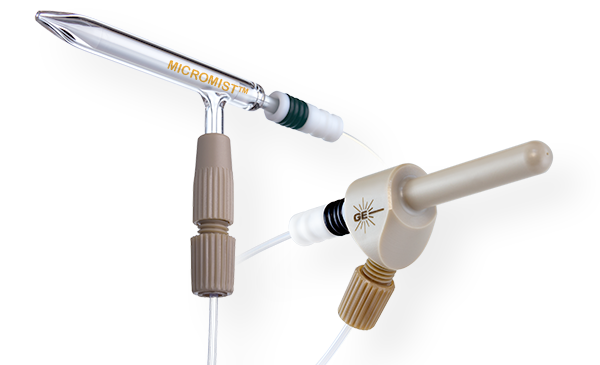
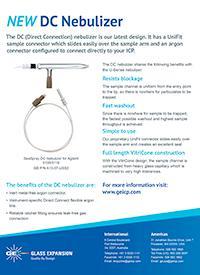
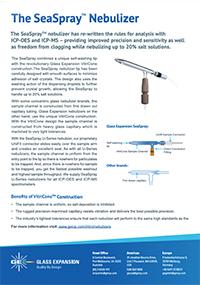

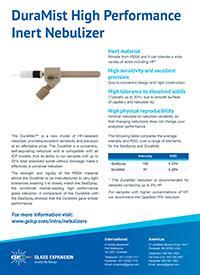
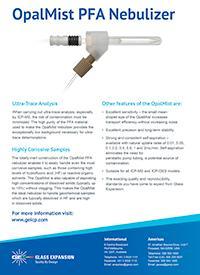
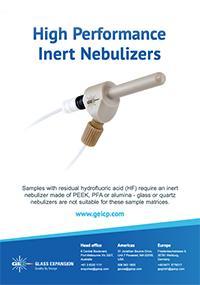
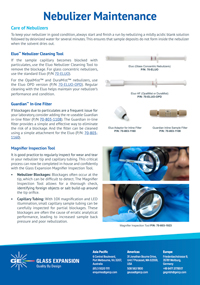
Customer Comments